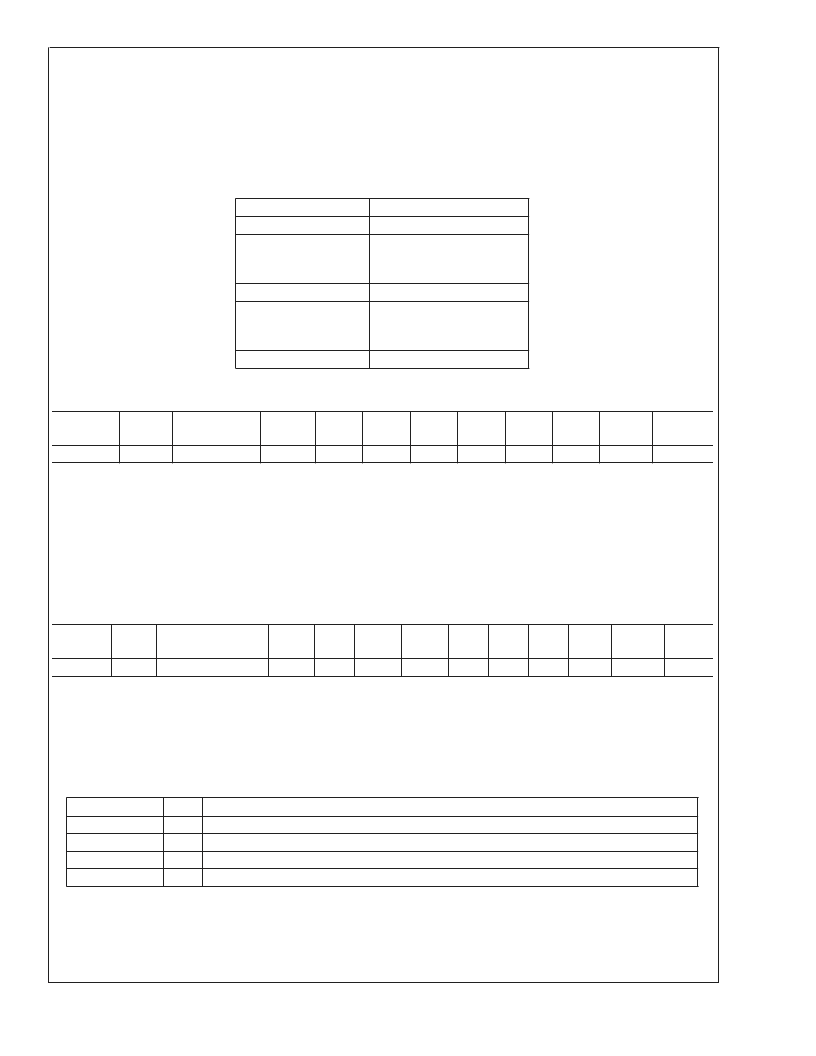- 您現(xiàn)在的位置:買賣IC網(wǎng) > PDF目錄358877 > LM96000 (National Semiconductor Corporation) Hardware Monitor with Integrated Fan Control PDF資料下載
參數(shù)資料
| 型號: | LM96000 |
| 廠商: | National Semiconductor Corporation |
| 英文描述: | Hardware Monitor with Integrated Fan Control |
| 中文描述: | 硬件監(jiān)控集成風扇控制 |
| 文件頁數(shù): | 25/28頁 |
| 文件大小: | 695K |
| 代理商: | LM96000 |
第1頁第2頁第3頁第4頁第5頁第6頁第7頁第8頁第9頁第10頁第11頁第12頁第13頁第14頁第15頁第16頁第17頁第18頁第19頁第20頁第21頁第22頁第23頁第24頁當前第25頁第26頁第27頁第28頁

Functional Description
(Continued)
– The fan will remain on, at Fan PWM Minimum, until the temperature goes a certain amount below Fan Temp Limit.
– The Hysteresis registers control this amount. See below table for details.
These registers become Read Only when the Ready/Lock/Start/Override register Lock bit is set. Any further attempts to write to
thses registers shall have no effect. After power up the default value is used whenever the Ready/Lock/Start/Override register
Start bit is cleared even though modifications to this register are possible.
TABLE 12. Hysteresis Settings
Setting
0h
.
.
.
5h
.
.
.
Fh
HYSTERESIS
0C
.
.
.
5C
.
.
.
15C
4.21 Register 6Fh: Test Register
Register
Address
6Fh
Read/
Write
R/W
Register
Name
Test Register
Bit 7
(MSB)
RES
Bit 6
Bit 5
Bit 4
Bit 3
Bit 2
Bit 1
Bit 0
(LSB)
XEN
Default
Value
00h
RES
RES
RES
RES
RES
RES
If the XEN bit is set high, the part will be placed into XOR tree test mode. Clearing the bit (writing a 0 to the XEN bit) brings the
part out of XOR tree test mode.
This register becomes Read Only when the Ready/Lock/Start/Override register Lock bit is set.Any further attempts to write to this
registers shall have no effect. After power up the default value is used whenever the Ready/Lock/Start/Override register Start bit
is cleared even though modifications to this register are possible.
4.22 Registers 70-7Fh: Vendor Specific Registers
These registers are for vendor specific features, including test registers. They will not default to a specific value on power up.
4.22.1 Register 74h: Tachometer Monitor Mode
Register
Address
74h
Read/
Write
R/W
Register
Name
Bit 7
(MSb)
RES
Bit 6
Bit 5
Bit 4
Bit 3
Bit 2
Bit 1
Bit 0
(LSb)
T1-0
Default
Value
00h
Lock
Tach Monitor Mode
RES
T3/4-1
T3/4-0
T2-1
T2-0
T1-1
Each fan TACH input has 4 possible modes of operation when using the low frequency range for the PWM outputs. Mode 0 is the
only mode that is available when using the high frequecy range for the PWM outputs. The modes for TACH3 and TACH4 share
control bits T3/4-[1:0]; TACH2 is controlled by T2-[1:0]; TACH1 is controlled by T1-[1:0]. The result reported in all modes is based
on 2 pulses per revolution. In order for modes 2 and 3 to function properly it is required that the:
PWM1 output must control the fan that has it’s tachometer output connected to the TACH1 LM96000 input.
PWM2 output must control the fan that has it’s tachometer output connected to the TACH2 LM96000 input.
PWM3 output must control the fans that have their tachometer outputs connected to the TACH3 or TACH4 LM96000 inputs.
Setting (Tn[1:0]) Mode Function
00
01
10
11
0
1
2
3
Traditional tach input monitor, false readings when under minimum detctable RPM
Traditional tach input monitor, FFFFh reading when under minimum detectable RPM
Most accurate readings, FFFFh reading when under minimum detectable RPM
Least effect on programmed PWM of Fan, FFFFh reading when under minimum detectable RPM
Mode 0:
This mode uses the conventional method for fan tachometer pulse detection and does not include any circuitry to
compensate for PWM Fan drive. This mode should be used when PWM drive is not used to power the fan. This mode may
report a false RPM reading when under minimum detectable RPM as shown in the following table.
Mode 1:
This mode uses the conventional method for fan tach detection. The reading will be FFFFh if it is below minimum
detectable RPM.
L
www.national.com
25
相關PDF資料 |
PDF描述 |
|---|---|
| LM96000CIMT | Hardware Monitor with Integrated Fan Control |
| LM96000CIMTX | Hardware Monitor with Integrated Fan Control |
| LM9617CCEA | Monochrome CMOS Image Sensor VGA 30 FPS |
| LM9617 | Monochrome CMOS Image Sensor VGA 30 FPS |
| LM9628EVAL-KIT | LM9628 Color CMOS Image Sensor VGA 30 FPS |
相關代理商/技術參數(shù) |
參數(shù)描述 |
|---|---|
| LM96000CIMT | 功能描述:板上安裝溫度傳感器 RoHS:否 制造商:Omron Electronics 輸出類型:Digital 配置: 準確性:+/- 1.5 C, +/- 3 C 溫度閾值: 數(shù)字輸出 - 總線接口:2-Wire, I2C, SMBus 電源電壓-最大:5.5 V 電源電壓-最小:4.5 V 最大工作溫度:+ 50 C 最小工作溫度:0 C 關閉: 安裝風格: 封裝 / 箱體: 設備功能:Temperature and Humidity Sensor |
| LM96000CIMT/NOPB | 功能描述:板上安裝溫度傳感器 HW Monitor RoHS:否 制造商:Omron Electronics 輸出類型:Digital 配置: 準確性:+/- 1.5 C, +/- 3 C 溫度閾值: 數(shù)字輸出 - 總線接口:2-Wire, I2C, SMBus 電源電壓-最大:5.5 V 電源電壓-最小:4.5 V 最大工作溫度:+ 50 C 最小工作溫度:0 C 關閉: 安裝風格: 封裝 / 箱體: 設備功能:Temperature and Humidity Sensor |
| LM96000CIMT/NOPB | 制造商:Texas Instruments 功能描述:Temperature Sensor IC |
| LM96000CIMTX | 功能描述:板上安裝溫度傳感器 RoHS:否 制造商:Omron Electronics 輸出類型:Digital 配置: 準確性:+/- 1.5 C, +/- 3 C 溫度閾值: 數(shù)字輸出 - 總線接口:2-Wire, I2C, SMBus 電源電壓-最大:5.5 V 電源電壓-最小:4.5 V 最大工作溫度:+ 50 C 最小工作溫度:0 C 關閉: 安裝風格: 封裝 / 箱體: 設備功能:Temperature and Humidity Sensor |
| LM96000CIMTX/NOPB | 功能描述:板上安裝溫度傳感器 RoHS:否 制造商:Omron Electronics 輸出類型:Digital 配置: 準確性:+/- 1.5 C, +/- 3 C 溫度閾值: 數(shù)字輸出 - 總線接口:2-Wire, I2C, SMBus 電源電壓-最大:5.5 V 電源電壓-最小:4.5 V 最大工作溫度:+ 50 C 最小工作溫度:0 C 關閉: 安裝風格: 封裝 / 箱體: 設備功能:Temperature and Humidity Sensor |
發(fā)布緊急采購,3分鐘左右您將得到回復。